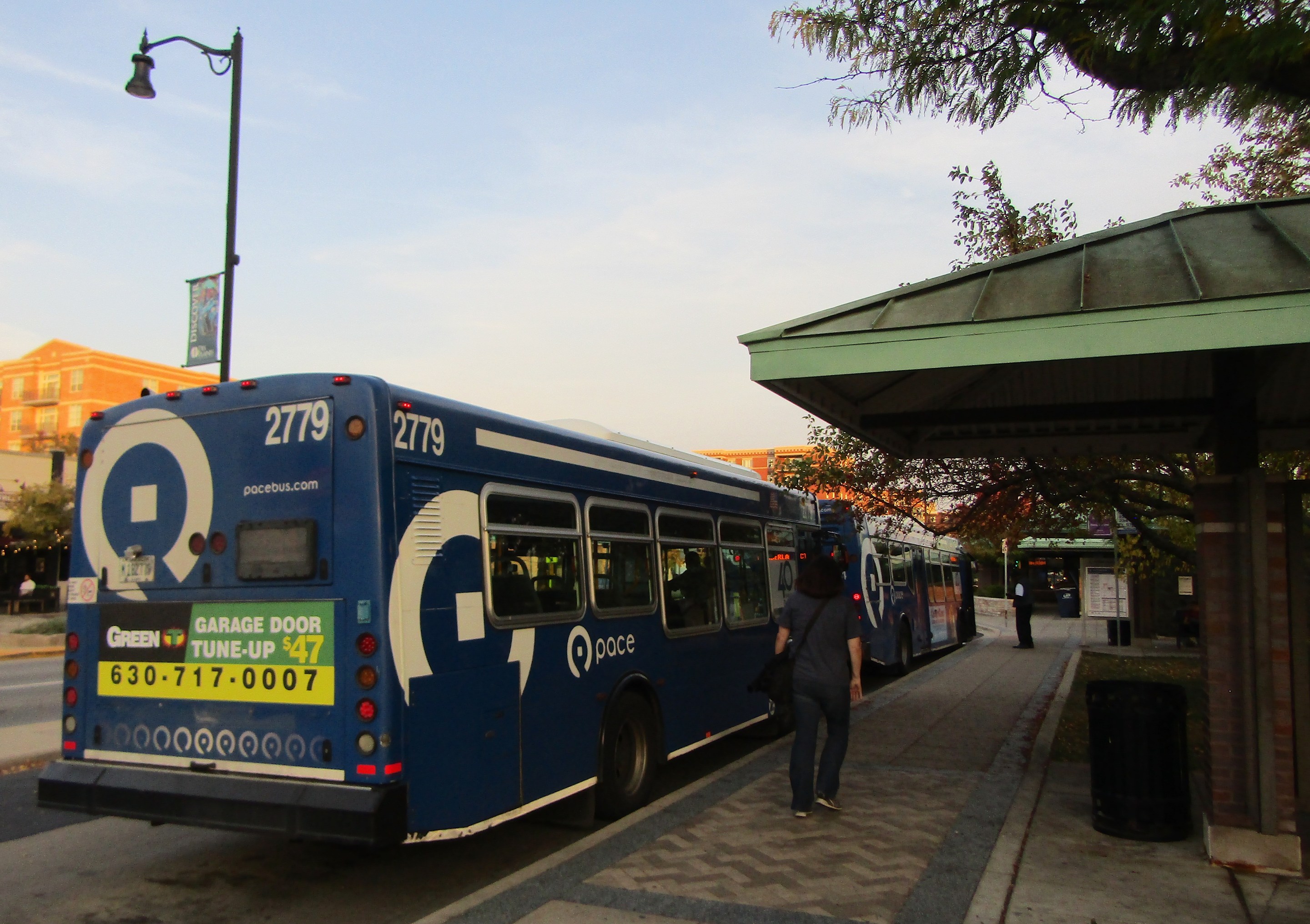
ReVision, Pace Suburban Bus’ long-discussed post-pandemic systemwide route revamp, is starting to take shape.
During the October 29 meeting of the Pace board’s Joint Planning and Infrastructure Committee, consultant Daniel Costantino, of Jarrett Walker + Associates, discussed three potential "network concepts." Two of them, "Plus 50 - Ridership" and "Plus 50 - Coverage," would require an infusion of state funding.
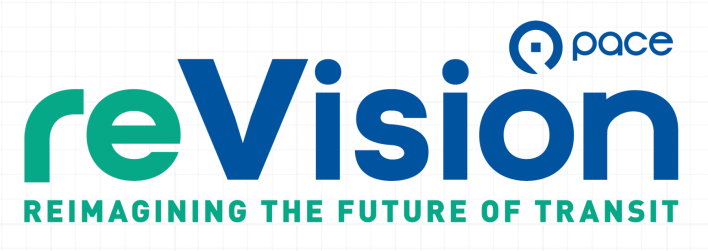
But currently, the Illinois General Assembly isn’t eager to give Chicagoland transit more cash without significant reforms to how the network is governed and financed, such as consolidation of the four local agencies. So there's also a "Plus 10 - Limited Investment" network concept, which "focuses on what Pace can do if current funding levels are maintained."
The Plus 50 - Ridership scenario would improve service to busier corridors and areas with higher ridership demand. Plus 50 - Coverage would focus on expanding the network, even if that means sacrificing frequency. The more modest Plus 10 - Limited Investment scenario would make smaller changes, but is probably more realistic.
All three network concepts call for more frequent Pace weekend service, especially on Sundays. That would be a big change in the collar counties, which get little or no Sunday service.
The maps shared during the meeting represent the first public draft of ReVision, and will probably see many changes before the plan is finalized, according to Pace spokesperson Maggie Daly Skogsbakken.
During the hearing, Constantino said that ideally Pace will settle on a network restructuring that would be some combination of the Ridership and Coverage concepts. Notably, his presentation only went into detail on the north suburban portion of the system. For the rest of the region, the maps only showed that there is some kind of bus service a particular corridor, without specifying whether that means the road is served by one continuous route, or portions of several different routes.
Plus 50 – Ridership
For the Plus 50 - Ridership network concept, the consulting firm mapped routes "between areas with density, major destinations, and many people with low incomes or no cars." There, the service demand is high enough to run buses every 15-30 minutes on both weekdays and weekends.
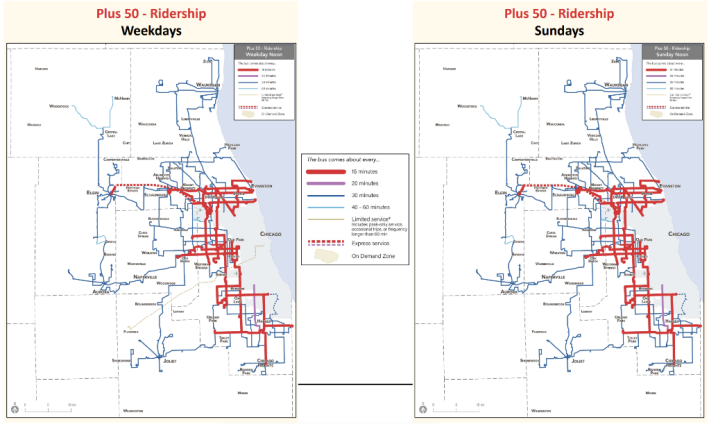
This doesn’t mean that all routes in these areas would run that frequently. Two McHenry County bus lines that are currently rush hour-only, routes 806 and 808, would lose sections beyond Woodstock and McHenry, respectively, and the remaining portions would run once an hour. Several major corridors within Cook County would see frequencies increase to every 15 minutes. But most corridors that would have service added, or at least not cut, would have 30-minute headways.
Perhaps most importantly, routes would have similar headways on weekdays and weekends – which would be uncharted territory for Pace. McHenry County currently has no weekend service whatsoever; there is no Sunday service in Kane, Will and most of Lake counties; and service in Cook and DuPage counties peters out significantly on the weekend.
Plus 50 - Ridership would reduce the already scant McHenry County fixed-route bus network. And major suburban municipalities like Joliet, Elgin and Waukegan would lose some local service.
According to Constantino, under this scenario 37 percent of suburban residents would live near transit (whether it’s Pace, Metra, or the CTA), down from 42 percent today. But this would triple the number of suburbanites who live near service with headways of no more than 15 minutes.
Plus 50 - Coverage
The Plus 50 - Coverage network concept "really has that ambition to get within a half mile of as many people as possible," Costantino said. "Most routes would have 60-minute headways, and most would run on Saturdays and Sundays. The 15-minute headways would be limited to corridors that either already have Arterial Rapid Transit Pulse service or are slated to get it in the future.
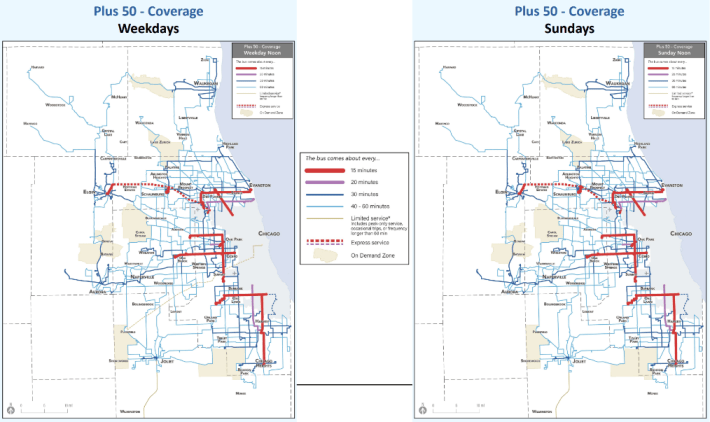
This concept adds bus service on many major corridors, and extends routes on the existing corridors. This would create transit connections that simply don’t exist today. For example, the service along the Williow Road/Palatine Road corridor would connect with Metra's Union Pacific North line’s downtown Winnetka station and Union Pacific Northwest line’s Palatine station.
The scenario notably expands fixed route service to southwest suburban Plainfield, which is currently only served by rush-hour commuter express buses, plus several collar-county suburbs with no fixed-route service. That list includes southwest suburban Streamwood, and northwest suburban Lake Zurich, Wauconda, and Marengo, a potential future intermediate stop for Chicago-Rockford Metra service.
Under this concept, 56 percent of all suburban residents would live near transit service. And 5 percent more suburbanites would be able to catch buses with 15-minute headways. But Costantino added that this increase in proximity to transit wouldn't actually equal more access to convenient transportation, since on average the suburban headways would be longer.
Plus 10 - Limited Investment
This network concept assumes that Pace won’t get any additional state funding beyond filling the gap created once COVID-era federal stimulus funding runs out in 2026, its staff is back to its pre-pandemic numbers, and the farebox recovery ratio kicks in again. (The latter is the requirement under Illinois law that Pace, the CTA, and Metra must bring in enough revenue through fares, advertising, etc. to pay for half of daily operating expenses.) Under this austerity scenario, Pace would only be able to make service adjustments to better fit post-pandemic travel patterns, Costantino said. "In the Plus 10 concept, we haven't focused so much on the ridership/coverage tradeoff, [because pivoting in either direction] would be disruptive for your network."
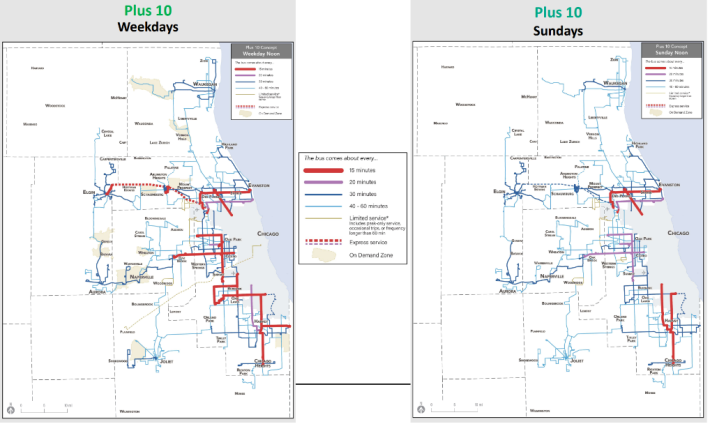
Under this concept, most of the routes would stay as is and operate seven days a week."You can make big improvements in the weekend service without making that much change to your route structure, and we know that in the post-COVID world, that's really important," Costantino said.
Shorter headways would mostly benefit major south- and west-suburban routes, and Lake and DuPage counties would get a little more service to major corridors. And it's worth reiterating that having weekend/Sunday service would be a major change for the collar counties.
Ridership versus Coverage
Costantino emphasized that the two Plus 50 scenarios were meant to be starting points. "We were not expecting, if Pace was funded at that level, that it would go in one or the other direction," he said. "Alternatives really [show] the range of possibilities that are going to help animate the conversation."
Pace board member Erin Smith, who represents McHenry County, admitted that she was torn between these two choices. "I would lean toward the model that follows ridership, so that we have buses that come more often,” she said. "And yet I say that knowing that it disadvantages McHenry County."
Smith echoed a recurring complaint from McHenry County officials: They pay the same tax to the Regional Transportation Authority (the agency that oversees Chicagoland transit) as other collar counties, but get the least for it. But she added that more investment doesn’t have to translate into fixed routes. She said better funding for the McRide Dial-a-Ride system and more on-demand service would work just as well.
Smith reflected that, when she was growing up in Chicago's Far Northwest Side Edgebrook neighborhood, she didn’t feel that having a car was necessarily, since she could get everywhere by bus without long headways. While acknowledging that this situation wouldn’t be practical to implement in more rural parts of the region, she argued that this is something Pace should strive for overall.
Pace is expected to begin public outreach on ReVision in mid-November, with three open house style meetings, plus focus groups. The first full-fledged draft plan won’t be ready until mid-summer, and the final version isn’t slated to be released until 2026 – just in time for the fiscal cliff.

Ever since the proposal to consolidate the four Chicago area transit agencies was announced, the leaders of Pace, the CTA, and Metra insisted that there is nothing wrong with the current structure. (Not coincidentally, they would likely lose their jobs if the four bureaus were fused into one. - Ed.) Instead, they argued that what’s need is investment that will allow their systems to fully live up to their potential. Both Plus 50 concepts make a good case for what Pace could be with more funding.
But even Plus 10 - Limited Investment would be a win for suburban riders. Expanded weekend service would be a game-changer.
Check out Pace's ReVision webpage here.

Did you appreciate this post? Please consider making a tax-deductible donation, to help keep Streetsblog Chicago's sustainable transportation news and advocacy articles paywall-free.
